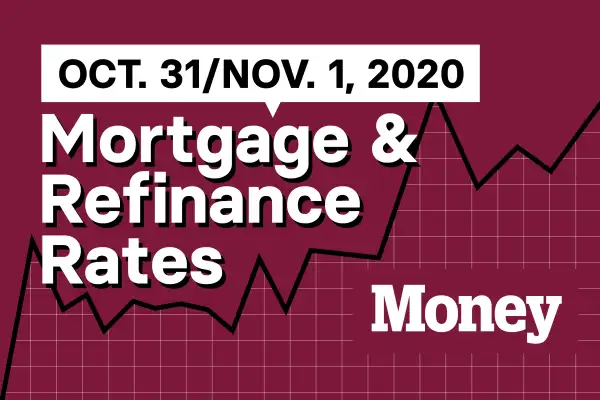Today's Mortgage and Refinance Rates for October 31 and November 1

The average rate for a 30-year fixed-rate purchase mortgage was 3.501% on Thursday. The average rate for a 30-year refinance was 4.315%.
Money's most recent mortgage rates include data from over 8,000 lenders across the United States and are updated daily. These rates include discount points and represent what a borrower with a 20% down payment and 700 credit scores — roughly the national average FICO score — would have been quoted.
| 30-year fixed-rate purchase mortgage |
| 3.501% |
| Rate of October 29, 2020 |
Mortgage rates vary from state to state. On Thursday, borrowers in Illinois were quoted the lowest mortgage rates — at 3.264%. People looking for mortgages in Nevada saw the highest average rate at 3.782%. Nationwide, borrowers with the highest credit scores, 740 and above, were quoted rates averaging 2.994%, while those with credit of 640 or below were shown rates of 4.729% — a 1.735 percentage-point spread.
You may be able to negotiate a lower rate if you shop around or if you have other accounts with the lender. (Money's picks for the best mortgage lenders are here.) Currently, some banks are hiking up advertised rates to keep demand in check, so you may be offered a lower rate if you reach out directly.
Freddie Mac's widely quoted Primary Mortgage Market Survey put rates at 2.81% with 0.6 points paid for the week ending October 29. The mortgage purchaser's weekly survey reflects borrowers who put 20% down on conforming loans and have excellent credit.
Refinance rates today
Money's most recent survey also shows that the offered rate for a 30-year refinance for someone with a 740 credit score was 3.733% on Thursday. Last October, the average mortgage rate (including fees) was 3.859%.
| 30-year fixed-rate mortgage refi |
| 3.733% |
| Rate of October 29, 2020 |
A homeowner with a $200,000 mortgage balance currently paying 3.859% on a 30-year could potentially cut their monthly payment from $939 to $924 by financing at the current lower rates. To determine if it's worth it to refinance your mortgage, also consider the closing fees you paid on your current mortgage, how much your new lender is charging and how long you have left on your loan term. (Our picks for the best lenders for refinancing are here).
The Week in Review
The real estate market continues on a hot streak, but as demand and home price growth slows there are signs that a cool down may be on its way.
Mortgage loan applications seem to be leveling off, as the total volume of loan applications increased just 1.7% for the week ending October 23, according to the Mortgage Bankers Association. Purchase loans ticked up by only 0.2% week-over-week, while refinance applications were up by 3%. Both types of loans were still well above last years' numbers, up 24% and 80% respectively.
According to the National Association of Realtors, pending home sales dropped slightly in September, down 2.2% month-over-month, breaking a streak of four consecutive months of gains. Only the Northeast region saw an increase in contract activity, rising by 2% from August. Signings were down by 3.2% in the Midwest, 2.6% in the the West and 3% in the South.
Industry experts were expecting a modest increase in pending sales. The decline could be a sign that the housing market has become more difficult for homebuyers as many of the more affordable homes have already been purchased. An inventory shortage, coupled with high demand, has sent prices skyward, leaving many homebuyers with no reasonable purchase options.
The CoreLogic/Case Shiller Home Price Index saw a year-over-year gain of 5.7% during the month of August, the fastest price accelerations since July 2018. The index is now 21% above its the pre-Great Recession high and above July's mark of 4.8%.
The largest price growth occurred in western cities, with Phoenix leading the way with a gain of 9.9%, followed by Seattle, up 8.5%, and San Diego, up 7.6%. The smallest gains occurred in Chicago, up just 1.2%, followed by New York with a gain of 2.8%. At the current pace, 2020 is set to be the strongest year for home sales since 2006.
The median home sale price increased 15% for the four week period ending October 18, up to a record-high of $320,625, according to real estate brokerage Redfin. It remains a seller's market, as the number of pending homes sales was 32% higher than last year. The average sale-to-price ratio, which measures how close to its asking price a home is sold, was at a record high 99.5%.
Meanwhile, listing prices continued on a torrid pace during the week ending October 24, increasing 12.2% week-over-week, according to Realtor.com. The price of a typical home stayed steady at $350,000 — which is $38,000 more than the same period last year. The pace of sales also kept steady from the previous week, but homes were selling 14 days faster year-over-year. However, there was an increase in the number of price reductions, a possible sign of a slowdown. The share of homes that were reduced in price reached 5.5%.
Inventory is still the biggest roadblock for many homebuyers. This year started with an inventory deficit of 15%. The situation that has only gotten worse due to the pandemic and as strong demand has saturated supply The inventory gap is as high as 50% in some areas.
While high home values would seem to be an incentive for homeowners to sell, that's not the case. According to a survey by real estate site Zillow, 34% of homeowners who are considering sell in their homes within the next three years cite uncertainty over current conditions as the main reason for not listing their property now, with another 31% citing financial uncertainty as the primary reason for not listing. About 40% said they believed they could get a higher price if they waited to sell.
Of all the homeowners surveyed, only 1% had their homes listed for sale. Of the remaining 99%, the most often cited reason for not listing their home at this time was the fear that they might not be able to find a home they could afford.
There may be good news on the inventory front, however, as new listings seem to be coming onto the market at a slightly faster pace than before. Data from Realtor.com for the week ending October 24 indicates that new listings were down only 2% from last year's level, and much improved over the previous week when new listings were down 6% year-over-year. While inventory remains 38% below last year's total, the deficit has remained fairly steady for the last six weeks, with no significant loss of supply and some small indications of gains.
While new listings were up 8% during the four-week period of the survey, the overall number of active listings was down 29% from last year. The pace of sale, however, is still going faster than usual for this time of year, with 45% of homes under contract getting an accepted offer within two weeks of being on the market.
According to the U.S. Census Bureau, the sale of newly-built single-family homes in September decreased by 3.5% from August, reaching a seasonally adjusted annual rate of 959,000 units. Despite the drop, that's still 32% more homes sold than in September of 2019. As a result of low interest rates, high demand, and low inventory, the median price of a new home increased from $315,700 in September 2019 to $326,800.
The slowdown in the pace of sales was expected, as the gap between the sale of new homes and single-family construction reached an all-time high in August, according to the National Association of Home Builders. The number of homes sold that hadn't been started yet was 47% higher than last August.
There were a seasonally adjusted 248,000 new homes for sale in September, representing a 3.6 month supply at the current pace of sales. Although a slight improvement over the August supply, inventory is 32% lower than last year. Only 48,000 units of the total inventory available for sale have been completed and are ready to be moved into.
The number of mortgage loans in forbearance has slowed down after two consecutive weeks of significant drops. According to the MBA, the share of loans in the payment deferral plans ticked down by 2 basis points to 5.90%. The share of Fannie Mae and Freddie Mac loans in the plans decreased for the 20th straight week, declining to 3.72%. While depository servicers also saw a decrease, all other loan types saw slight increases.
The labor market continued its slow improvement as the Department of Labor reported that initial jobless claims for the week ending October 24 came in at 751,000, below economists' expectations of 778,000 and 40,000 fewer claims than last week's revised total of 791,000. The four-week moving average was 7,878,750. Continuing claims decreased by 709,000 to a total of 7,756,000. The seasonally adjusted insured unemployment rate dipped to 5.3%.
Meanwhile, the Bureau of Economic Analysis released its initial estimate of gross domestic product for the third quarter of 2020, indicating that the economy expanded by 7.4% during the quarter — an annual rate of 33.1%. The record growth had been expected by economists after the economy contracted by 9% during the second quarter and by 1.3% during the first quarter. Despite the record growth in the third quarter, the economy is still 3.5% smaller than it was at the end of 2019.
Bottom line:
Are We Headed for Another Foreclosure Crisis? 9 Housing Experts Share Their Predictions
Rates are subject to change. All information provided here is accurate as of the publish date.

